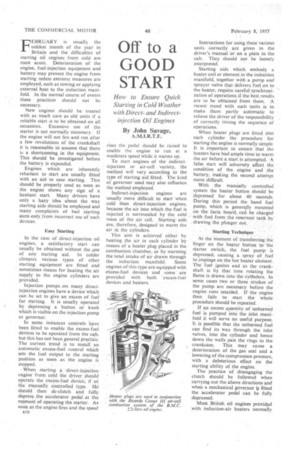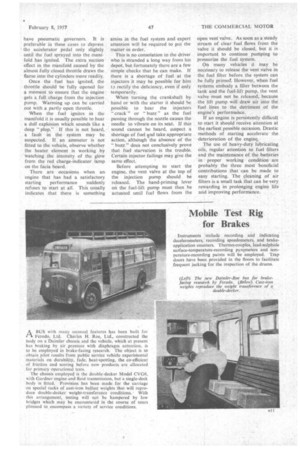Off to a GOOD START
Page 44

Page 45

If you've noticed an error in this article please click here to report it so we can fix it.
How to Ensure Quick Starting in Cold Weather with Directand Indirectinjection Oil Engines By John Savage,
A.M.I.R.T.E. FEBRUARY is usually the coldest month of the year in Britain and the difficulties of starting oil engines from cold are most acute. Deterioration of the engine, fuel-injection equipment and battery may prevent the engine from starting unless extreme measures are employed, such as towing or applying external heat to the induction manifold. In the normal course of events these practices should not be necessary.
New engines should be treated with as much care as old units if a reliable start is to be obtained on all occasions. Excessive use of the starter is not normally necessary.If the engine will not fire and run after a few revolutions of the crankshaft it is reasonable to assume that there is a shortcoming in the equipment. This should be investigated before the battery is expended.
Engines which are inherently reluctant to start are usually fitted with an aid to ease starting. This should be properly used as soon as the engine shows any sign of a hesitant start. Many drivers have only a hazy idea about the way starting aids should be employed and many complaints of bad starting stem only from incorrect use of ,such devices.
Easy Starting In the case of direct-injection oil engines, a satisfactory start can
usually be obtained without the ,use
of any starting aid. In colder climates various types of ether starting equipment are fitted and sometimes means for heating the air supply to the engine cylinders are provided.
Injection pumps ,on many directinjection engines have a device which can be set to give an excess of fuel for starting. It is usually operated by depressing a button or knob which is visible on the injection pump or governor.
In some instances controls have been fitted to enable the excess-fuel devices to be operated from the cab, but this has not been general practice. The current trend is to install an automatic excess-fuel control which sets the fuel output to the starting position, as soon as the engine is
stopped. . • When starting a direct-injection engine from cold the driver should operate the excess-fuel device, if of the manually Controlled type. He' should then de-clutch and .fully depress the accelerator pedal at the moment of operating the starter.. As soon as the engine fires and the speed 1110 rises the pedal should be raised to enable the engine to run at a moderate speed while it warms up.
To start engines of the indirectinjection or air-cell variety, the metho.d will vary according to the type of starting aid fitted. The kind of governor used may also influence the method employed.
Indirect-injection engines are usually more difficult to start when cold than direct-injection engines, because the air into which the fuel is injected is surrounded by the cold mass of the air cell. Starting aids are, therefore, designed to warm the air in the cylinders.
This aim is achieved either by heating the air in each cylinder by means of a heater plug placed in the combustion charriber, or by warming the total intake of air drawn through the induction manifold. Some engines a this type are equipped with ekcess-fuel devices and some are provided with • both -excess-fuel devices and heaters.
Instructions for using these various units correctly are given in the driver's manual or on a plate in the cab. They should not be loosely interpreted.
Starting aids which embody a heater coil or element in the induction manifold, together with a pump and sprayer valve that delivers fuel on to the heater, require careful synchronization of operations if the best results are to be obtained from them. A recent trend with such 'units is to make them partly automatic to relieve the driver of the responsibility of correctly timing the sequence of operations.
When heater plugs are fitted into each cylinder the procedure for starting the engine is normally simple. It is important to ensure that the heaters have had ample time to warm the air before a start is attempted. A false start will adversely affect the condition of the engine and the battery, making the second attempt more difficult.
With the manually controlled system the heater button should be depressed for about 40 seconds. During this period the hand fuel pump, which is generally mounted on the facia board, can be charged with fuel from the reservoir tank by • drawing the plunger but.
Starting Technique At the moment of transferring thc finger on the heater button to the starter switch, the fuel pump is depressed, causing a spray of fuel to impinge on the hot heater elernent.
The fuel ignites and as the crankshaft is by that time rotating the flame is drawn into the cylinders. In some cases two or three strokes of the pump are necessary before the engine runs unaided. If the engine then fails to start the whole procedure should be repeated.
If an excess quantity of unburned fuel is pumped into the inlet manifold it will serve no useful purpose. It is possible that the unburned fuel can find its way through the inlet valves, into the cylinder and hence down the walls past the rings to the crankcase. This may cause a deterioration of the gas seal and a lowering of the compression pressure, with a deleterious effect on the starting ability of the engine.
The practice of disengaging the clutch should be followed when carrying out the above directions and when a mechanical governor is fitted the accelerator pedal can be fully depressed.
Most British oil engines providpd with induction-air heaters normally
have pneumatic governors. It is preferable in these cases to depress the .accelerator pedal only slightly until the fuel sprayed into the manifold has ignited. The extra suction effect in the manifold caused by the almost fully closed throttle draws the flame into the cylinders more readily.
Once the fuel has ignited, the thi.ottle should be fully opened for a moment to ensure that the engine gets a full charge from the injection pump. Warming up can be carried out with a partly open throttle.
When the fuel ignites in the manifold it is usually possible to hear a dull explosion which sounds like a deep " plop." If this is not heard, a fault in the system. may be suspected. if an ammeter is not fitted to the vehicle, observe whether the heater element is working by -watching the intensity of the glow from the red charge-indicator lamp on the facia board.
There are occasions when an engine that has had a satisfactory starting performance suddenly refuses to start at all. This usually indicates that there is something amiss in the fuel system and expert attention will be required to put the matter in order.
• This is no consolation to the driver who is stranded a long way from his depot, but fortunately there are a few simple checks that he can make. It there is a shortage of fuel at the injectors it may be possible for him to rectify the deficiency, even if only temporarily.
When turning the crankshaft by hand or with the starter it should he possible to hear the injectors " crack " or " buzz " as the fuel passing through the nozzle causes the needle to vibrate on its seat. If this sound cannot be heard, suspect a shortage of fuel t nd take appropriate action, although the absence of the " buzz " does not conclusively prove that fuel starvation is the trouble. Certain injectorfailings may give the same effect.
Before attempting to start the engine, the vent valve at the top of the injection pump should be released. The hand-priming lever on the fuel-lift pump must then be actuated until fuel flows from the open vent valve. As soon as a steady stream of clear fuel flows from the valve it should be closed, but it is important to continue pumping to • pressurize the fuel system.
On many vehicles it may be necessary to release the vent valve in the fuel filter before the system can be fully primed. However, when fuel systems embody a filter between the tank and the fuel-lift pump, the vent valve must not be released, because the lift pump will draw air into the fuel lines to the detriment of the engine's performance.
If an engine is persistently difficult to start it should receive attention at the earliest possible occasion. Drastic methods of starting accelerate the deterioration of the engine.
The use of heavy-duty lubricating oils, regular attention to fuel filters and the maintenance of the batteries in proper working condition are probably the three most beneficial contributions that can be made to easy starting. The ,cleaning of air filters is a small task that can be very rewarding in prolonging engine life and improving performance.




































































































